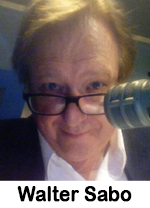By Walter Sabo
Consultant, Sabo Media Partners
A.K.A. Walter M. Sterling
Radio Host, “Sterling On Sunday”
Talk Media Network
 To be an expert in marketing requires expertise in how memory works. Early in my consultant practice, I studied and read every book I could find on the processes of memory. The best book is Effective Frequency: The Relationship Between Frequency and Advertising Effectiveness. Put simply, how many times does a consumer have to hear a message before it has impact? The book, a collection of studies, is the foundation for every qualitative study in the field today.
To be an expert in marketing requires expertise in how memory works. Early in my consultant practice, I studied and read every book I could find on the processes of memory. The best book is Effective Frequency: The Relationship Between Frequency and Advertising Effectiveness. Put simply, how many times does a consumer have to hear a message before it has impact? The book, a collection of studies, is the foundation for every qualitative study in the field today.
Knowing the foundation studies of frequency’s impact facilitates sales, promo scheduling, topic rotation and external station marketing. No marketing budget? Mistake. The most efficient investment in a radio station’s growth is external advertising. Heightened awareness of a station increases cume, key for direct response advertisers, and makes sales calls shorter because the station is familiar to buyers, improves morale, and minimizes competition.
Key take aways from this book of secrets:
The Law of Six: For a message to have impact, it must be heard by the target six times during the length of the campaign.
The Law of Seven: Why are there seven (7) digits in phone numbers? Over a hundred years ago the phone company had to determine how many digits we could handle. They researched how many items we could remember in any product category. How many brand name soaps, tires, shampoos, deodorants. etc. Try it. Write down all the shampoo brands or tire brands you can think of. I’ve performed this magic act with large audiences around the country.
Almost no one can write down more than seven shampoo, deodorant, cereal, or tire brands. The exception is if the question asks you to write down brands of an industry in which you work. Memory activity applies to the use of presets on car radios. Analog car radios rarely fill all five or six pre-set buttons. In your digital car, even though you’re in radio, I bet the most you’ve programmed is four.
Flight or Dose? A $5,000,000 national campaign was tested for flight effectiveness. What works best? Two weeks on, two weeks off or continuous spots. Same number of spots, same budget but continuous or flighted? Two surprising answers: The flighted campaign resulted in more sales. But the continuous run actually hurt sales and after an initial positive impact, sales declined to pre-campaign levels.
Youth Matters: The younger the customer, the more often they must be exposed to the message. A young person has more distractions than an older person.
People Forget: This is the key takeaway: If a product is not advertised for nine months, customers have no memory of the message. None. They might remember that the product exists, but they have no recall of what the product does for them or why they should buy it… or listen to it. A tragic, industry-wide mistake has been made to cease advertising radio stations. Obviously not advertising is hypocritical for a medium that survives on ad dollars. The no-marketing argument is that with the PPM there is no need to remind listeners of a station’s name because the listener no longer has to write it down in a diary. How much has your city changed in nine months? How many new streams, websites, podcasts have distracted your listener from your station? External marketing of a station protects the investment made in its operation.
Walter Sabo has been a C Suite action partner for companies such as SiriusXM, Hearst, Press Broadcasting, Gannett, RKO General and many other leading media outlets. His company HITVIEWS, in 2007, was the first to identify and monetize video influencers. HITVIEWS clients included Pepsi, FOX TV, Timberland, Microsoft, and CBS Television. He can be reached at walter@sabomedia.com and www.waltersterlingshow.com. “Sterling On Sunday,” from Talk Media Network airs 10:00 pm-1:00 ET, now in its 10th year of success.


